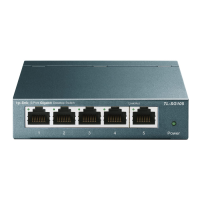TL-SL5428E
24-port 10/100Mbps + 4-port Gigabit L2 Managed Switch CLI Guide
139
Chapter 25 ACL Commands
ACL (Access Control List) is used to filter data packets by configuring a series of match conditions,
operations and time ranges. It provides a flexible and secured access control policy and facilitates
you to control the network security.
acl time-segment
Description
The acl time-segment command is used to add Time-Range. To delete the
corresponding Time-Range, please use no acl time-segment command. A
time-range based ACL enables you to implement ACL control over packets by
differentiating the time-ranges. A time-range can be specified in each rule in an
ACL. The rule takes effect only when the specified time-range is configured and
the system time is within the time-range.
Syntax
acl time-segment {name} [start-time start-time] [end-time end-time]
[week-day week-day] [start-date start-date] [end-date end-date] [holiday
{ disable | enable }]
no acl time-segment {name}
Parameter
name —— The Time-Range name, ranging from 1 to 16 characters.
start-time —— The start time of the time-slice, in the format of HH:MM. By
default, it is 00:00.
end-time —— The end time of the time-slice, in the format of HH:MM. By
default, it is 23:59.
week-day —— Period Mode, in the format of 1-3,6 or daily, off-day,
working-day. 1-3,6 represent Monday, Tuesday, Wednesday and Saturday; daily
represents every day; off-day represents weekend and working-day represents
working day. By default, the period mode is disabled.
start-date —— The start date in Absoluteness Mode, in the format of
MM/DD/YYYY. By default, it is 01/01/1970.
end-date —— The end date in Absoluteness Mode, in the format of
MM/DD/YYYY. By default, it is 12/31/2099. The absoluteness mode will be
disabled if the start date and end date are both not configured.

